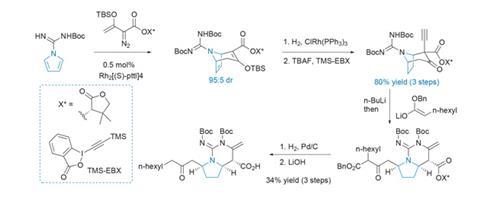Taming basic and reactive nitrogen atoms makes alkaloids more attractive targets, says BRSM
Of all the diverse substances that nature produces, the alkaloids – small molecules containing basic nitrogen – have had the greatest impact on human history and health. Beyond natural products, every single one of the 25 best-selling drugs in 2014 contains at least one nitrogen atom. It is an almost ubiquitous feature in our most bioactive molecules. However, for the inexperienced chemist, nitrogenous compounds are also a total pain to work with in the lab.
Unfortunately, the same features that tend to make nitrogen-containing molecules so good at interacting with biological systems – their basicity, polarity, nucleophilicity, and ease of oxidation – are also responsible for their notorious side-reactions and purification problems. The intractability of nitrogenous molecules is legendary, giving rise to an old adage among alkaloid chemists: ‘For every nitrogen atom in your natural product, add a year to your PhD.’ Although this aphorism is now less true than ever, thanks to advances in synthetic methodology and modern chromatography, many chemists are still understandably wary of these kinds of targets.

However, sometimes potent enough biological activity or a particularly intriguing structure is enough for chemists to overcome their initial fears and undertake a total synthesis. A synthesis of the anti-HIV natural product batzelladine B by Seth Herzon and co-workers at Yale University, US, shows that, with careful synthetic planning, even the most unappealing, nitrogen-laden natural products can be tackled successfully.
As the target contains nine nitrogens – present as three inconveniently basic guanidine units – some protecting group chemistry is inevitable. However, as well as tempering the reactivity of nitrogen atoms by using traditional carbamate protecting groups, the group also employs a clever tactic of burying them within aromatic rings to make certain intermediates easier to handle. In fact, both pyrrolidine rings present in the natural product are initially introduced as aromatic pyrroles, partly to make things a bit easier in the lab, but also because this enables the team to do chemistry that would otherwise be impossible.
Synthesis of the top tricyclic unit begins with an impressive [4+3] cycloaddition between a pyrrole and a donor–acceptor carbenoid (figure 1). This breaks the pyrrole’s aromaticity, simultaneously setting two out of the molecule’s three stereogenic centers, but would be impossible with a saturated pyrrolidine. Unfortunately, it requires a chiral auxiliary on the diazoester substrate, as well as the chiral ligand on the rhodium catalyst, to achieve good stereoselectivity. Luckily, using a diazoester derived from (–)-pantolactone – an inexpensive degradation product of vitamin B5 – imparts very high diastereoselectivity in conjunction with the chiral catalyst.

Next, the remaining double bond in the pyrrole-derived ring is hydrogenated with Wilkinson’s catalyst. An acetylene unit is added to the enol ether using TMS-EBX, an electrophilic benziodoxolone alkynylation reagent. Treating the resulting b-ketoester with lithium benzyl octanoate then leads to a spectacular reaction cascade – 1,2-addition, then retro-aldol, proton transfer, isomerisation and cyclisation – rearranging the bridged bicyclic system to the desired azaindolizidine and adding the aliphatic sidechain at the same time. Finally, removing the unwanted benzyl ester by decarboxylation, and hydrolytic cleavage of the chiral auxiliary complete the bicyclic fragment.
The second half of the molecule is also synthesised from a pyrrole-derived building block, with the guanidine formed from a creative transformation of the pyrrole nitrogen protecting group. The two halves are then joined through a delicate esterification (figure 2). Finally, exposing a mixture of the coupled compound and palladium-on-carbon to trifluoroacetic acid, then introducing a hydrogen atmosphere, removes all five protecting groups, forms the final ring by reductive amination, and selectively reduces the remaining pyrrole ring, completing the natural product in style.
BRSM is a postdoctoral researcher and blogger based in the US
References
B T Parr, C Economou and S B Herzon, Nature, 2015, 525, 507 (DOI: 10.1038/nature14902)












No comments yet